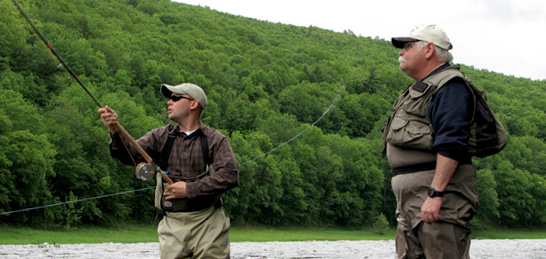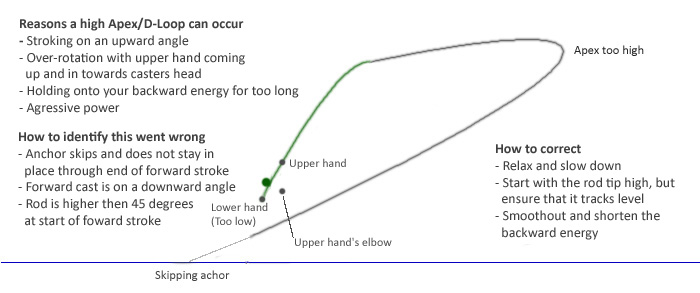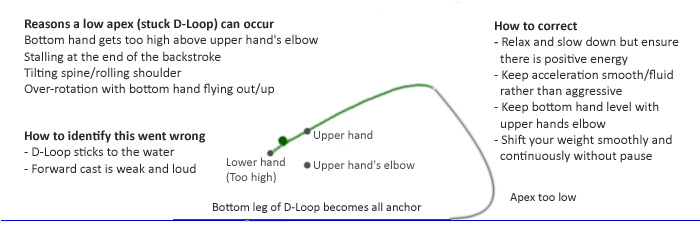The Art and Joy of Spey Casting
Spey Cast; A roll cast with a change in direction and significant increase in energy
Click here to go to our lesson page
Why spey cast
Why spey cast
- Little room needed - Spey casting allows you to minimize the amount of line you carry behind you whether using a single or two handed rod. This makes brush covered or high bank fishing situations possible.
- Change direction easily - Taking your line from straight downstream and casting it back out at a 45-90 degree angle to the current is easy and effortless, very little stripping and no false casting.
- Less effort - A two-hand rod requires very little effort to cast. Your lower hand takes all of the stress off of your dominant casting upper hand.
- Better line control - Being longer, two-hand rods manage and control your fly line much better than conventional fly rods. Fly control is one of the best ways to increase your catch rate.
- Less stripping - Since spey rods can handle longer lengths of line, there can be very little stripping involved between casts.
- Increase your skills - Spey casting is proven to enhance all casting techniques including single hand overhead.
- Fun & rewarding - Being more involved than conventional methods, spey casting is fun and rewarding to learn.
Spey Casting Terminology
- Anchor - The front portion of your line that stays attached to the water during the forward stroke. This is usually the fly, tippet, leader and sometimes up to a few feet of fly line. This enables the "D-loop" to load the rod. The anchor is always set in front of and to the side of the caster from which he/she is casting.
- D-loop - The belly of line from the tip of the rod to the anchor. The D loop is what creates the load on your rod and essentially serves as your "back cast."
- D-Loop Apex - Point that separates bottom and top of D-loop
- Aerialized Anchor Cast - Cast accomplished by setting the anchor and forming the D-loop with one move. Also known as "Touch and go" cast. Examples: Single Spey and Spiral/Snake Roll casts.
- Sustained Anchor Cast - Cast accomplished by presetting the anchor and then forming the D-loop on the second move. Examples: Double Spey and Stap T casts.
- River Left - Current moving to one's left.
- River Right - Current moving to one's right.
- 180 Degree Principal - Your D-loop (specifically the top leg of the D-loop) should be 180 degrees opposite your intended target.
Spey Casting Basics
Spey casting is an art form. It can be difficult to master, but once the basics of the casts are understood, it is actually very easy to accomplish. The difference between each cast is essentially how you set your anchor depending upon river left, river right and wind direction. The sweep, which forms the D-loop, is always the same. There will be a difference as to how you set up each cast, but the sweep and forward stroke should remain the same. Here are 10 basic principals to follow during the sweep and forward cast.
Before reading the 10 tips below, try to not think about what you should be doing, while you're doing it. The biggest factor that holds people back from advancing their skills is to overthink what they are doing, or more specifically think about it while they are doing it. This throws off tempo and acceleration, so even if the technique (track of the rod) is good, you won't be able to make the cast work, so over-rotation and other mistakes happen to try and compensate for the lack of energy. Think before the cast and after the cast about how your going to make the cast and then after what went wrong, if anything...
Spey casting is an art form. It can be difficult to master, but once the basics of the casts are understood, it is actually very easy to accomplish. The difference between each cast is essentially how you set your anchor depending upon river left, river right and wind direction. The sweep, which forms the D-loop, is always the same. There will be a difference as to how you set up each cast, but the sweep and forward stroke should remain the same. Here are 10 basic principals to follow during the sweep and forward cast.
Before reading the 10 tips below, try to not think about what you should be doing, while you're doing it. The biggest factor that holds people back from advancing their skills is to overthink what they are doing, or more specifically think about it while they are doing it. This throws off tempo and acceleration, so even if the technique (track of the rod) is good, you won't be able to make the cast work, so over-rotation and other mistakes happen to try and compensate for the lack of energy. Think before the cast and after the cast about how your going to make the cast and then after what went wrong, if anything...
- Relax - A loose grip and relaxed body is a must for improving technique.
- Cradle the rod gently with your palm up - This will keep your elbow more stable, keep your sweep flatter and set you up better for the forward stroke.
- Shift your weight - It is important that your upper body moves back an forth using your legs. During the sweep, while the rod is in front of you, you should be shifting backwards and while the rod is behind you, you should be shifting forwards. Never stall your weight shift. Keep the cast moving, it should be one fluid motion.
- Keep your hands "quiet" and stable - Your weight shift and a subtle rotation of your shoulders should bring the rod through the stroke. Your hands should move in sink with your body and your upper hand's elbow should remain still relative to your body.
- Keep your spine vertical - This will help keep your rod tracking parallel to the water. If you tilt your spine/roll your shoulder you will dip the rod tip and ultimately hurt your cast.
- Sweep with a slow and smooth acceleration - You must maintain the bend in your rod by sweeping smoothly and continuously.
- Sweep level - Track your rod tip flat/absolutely parallel to the water's surface during the back stroke. A good rule of thumb is to track the rod tip approximately 5 feet above the waters surface.
- Sweep short - Your rod tip should track flat to just behind perpendicular to your target and you should transition forward by shifting your weight and allowing your hands to "go along for the ride".
- Unload the forward cast by stopping your momentum - If you stop your body's momentum at 12:00, the rod should follow through to 10:30 on it's own, providing you are relaxed.
- Keep your upper hand on the side of your body that you are casting on - A common mistake is to slice in front of yourself on the forward stroke. Stay in a straight line towards your target.
A Proper D-Loop
D-Loop with High Apex (Improper)
D-Loop with Low Apex (Improper)
Click here to go to our spey lesson pageSpey Casting





